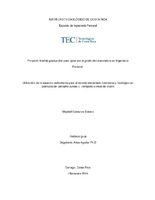Utilización de la espectro radiometría para el estudio del estado nutricional y fisiológico en plántulas de Jatropha curcas L. (tempate) a nivel de vivero
Abstract
In Costa Rica, cultivation of Jatropha curcas has become more important in recent years due to the great potential of the oil inside the seeds of this species for biodiesel production. For proper handling of this cultivation is necessary to become familiar with all the agronomic practices including the plant’s nutritional status. Traditionally, different techniques have been used to make decisions about nutrition. However, most techniques are not able to quickly meet the needs in real time, and in a harmless way. This research proposes a validation of the spectral radiometry for the detection of nutritional deficiencies in Jatropha curcas. The study was held at the research center of the University of Costa Rica called Estación Experimental Agrícola Fabio Baudrit Moreno. In this experimental station, the Jatropha curcas plants were organized into an experimental design of five randomized complete blocks; each block had four experimental units, each unit with 16 trees in individual pots. For evaluations and physiological measurements, just the four central trees were considered effective. A total of 80 trees were evaluated throughout the experiment during three measurement periods (October, November, and December). In order to simulate different nutritional conditions, four treatments were implemented. Each treatment had different substrates, on a scale from the lowest fertility substrate to the higher fertility substrate, with contrasting physical and chemical properties. The measure of the spectral response, the chlorophyll determination through SPAD, the measurement of the concentration of elements in the leaves, and the determination of the specific leaf area were studied for all, 80, trees in the three stages of measurement. Data were analyzed through an Analysis of Variance (ANOVA) and a multiple comparison tests using Tukey’s method (α=0,05). Relationships between variables were created through a multiple correlation analysis (mostly using the Pearson correlation coefficient for linear relationships). Regarding the spectral response, October showed significant differences between treatments; November and December presented differences between both, blocks and treatments. In the statistics, the SPAD values showed important differences between treatments in December. A positive linear relationship could be seen between the SPAD readings and leaf nitrogen concentration (r=0,85), sulfur (r=0,70), and phosphorus (r=0,75). No significant relationship in the specific leaf area was found between the SPAD values (r=0,13) and the nitrogen concentration in the leaves (r=0,42). Low correlations were found between the Normalized Difference Vegetation Index (NDVI) with SPAD values (r=0,53) and the nitrogen concentration (r=0,53). Lastly, a positive correlation was found between the NDVI and phosphorus (r=0,75) and zinc (r=0,80) in the leaves. Therefore the use of spectral techniques is viable for the assessment of nutritional and physiological status of the Jatropha curcas plants. This
4
conclusion suggests further research through experiments about the missing element and with better control of nutritional deficiencies to validate the use of spectral radiometry
Description
Proyecto de Graduación (Licenciatura en Ingeniería Forestal). Instituto Tecnológico de Costa Rica, Escuela de Ingeniería Forestal, 2014.


